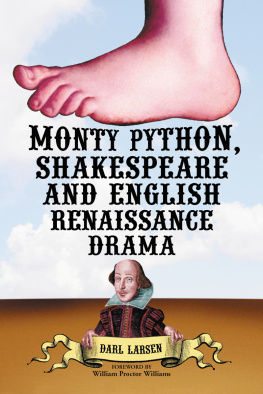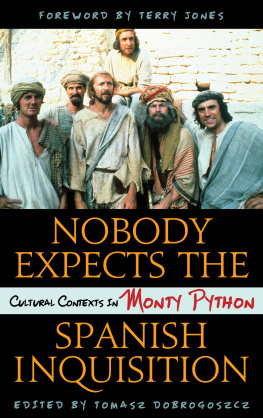A Book about the Film Monty Pythons Life of Brian
A Book about the Film Monty Pythons Life of Brian
All the References from Assyrians to Zeffirelli
Darl Larsen
Rowman & Littlefield
Lanham Boulder New York London
Published by Rowman & Littlefield
A wholly owned subsidiary of The Rowman & Littlefield Publishing Group, Inc.
4501 Forbes Boulevard, Suite 200, Lanham, Maryland 20706
www.rowman.com
Unit A, Whitacre Mews, 26-34 Stannary Street, London SE11 4AB
Copyright 2018 by Rowman & Littlefield
All rights reserved . No part of this book may be reproduced in any form or by any electronic or mechanical means, including information storage and retrieval systems, without written permission from the publisher, except by a reviewer who may quote passages in a review.
British Library Cataloguing in Publication Information Available
Library of Congress Cataloging-in-Publication Data
Names: Larsen, Darl, 1963 author.
Title: A book about the film Monty Pythons Life of Brian : all of the references from Assyrians to Zeffirelli / Darl Larsen.
Description: Lanham : Rowman & Littlefield, [2018] | Includes bibliographical references and index.
Identifiers: LCCN 2017033575 (print) | LCCN 2017051435 (ebook) | ISBN 9781538103661 (electronic) | ISBN 9781538103654 (hardback : alk. paper)
Subjects: LCSH: Life of Brian (Motion picture)
Classification: LCC PN1997.L575 (ebook) | LCC PN1997.L575 L37 2018 (print) | DDC 791.43/72dc23
LC record available at https://lccn.loc.gov/2017033575
 The paper used in this publication meets the minimum requirements of American National Standard for Information SciencesPermanence of Paper for Printed Library Materials, ANSI/NISO Z39.48-1992.
The paper used in this publication meets the minimum requirements of American National Standard for Information SciencesPermanence of Paper for Printed Library Materials, ANSI/NISO Z39.48-1992.
Printed in the United States of America
For Dad,
Norbert W. Larsen,
19352015

Acknowledgments
This kind of book project doesnt happen without loads of help, so there are thanks to be given. A couple of years ago I was caught off guard by Doug Fabrizio of Radio West, who asked when a Life of Brian book might be expected. Id just finished A Book about the Film Monty Python and the Holy Grail, so I was tired and maybe even cranky. I think I may have tactfully answered Never. Just weeks later, that prompt turned into a niggling, then into the beginnings of this book, so a thanks to Doug is in order.
Stephen Ryan and Rowman & Littlefield were good enough to push the project through, and Im grateful for their continuing enthusiasm. My BYU Theatre and Media Arts colleagues Wade Hollingshaus, Dean Duncan, Sharon Swenson, Tom Russell, Benjamin Thevenin, Brad Barber, Scott Christopherson, Tom Lefler, Kelly Loosli, Jeff Parkin, Megan Sanborn-Jones, and Amy Jensen helped make this book a reality; and Elizabeth Funk, Kyle Stapley, and the terrifically helpful front desk team all carried waterthanks. Profs. Roger Macfarlane and Rob McFarland assisted with Latin and German translations, respectively, and my research assistants Emily Bade, Jessica Cahill, and Helen Butcher provided wonderful, crucial material. Kimball Maw Jensen and Martha Rallison taught courses for me so I could have release time, while my dissertation advisor, mentor, and friend William Proctor Williams is ever in my corner, and Im grateful. The Harold B. Lee Library and especially the resourceful people at Interlibrary Loan bent over backwards, again, to get me everything I needed for such an expansive subject.
Mom and Dad, Patricia and Norbert Larsen, continue to be as helpful and loving as can be imagined. My amazing wife, Nycole, my children and their spousesKeir (Misti), Emrys (Cat), Brynmor (Chad), and Eamonn, Dathyl, Ransom, and Culainnand granddaughter, Hayden, are constant fans who encourage me to work on what makes me happy. Thank you all.

Introduction
It is a tale of unrelieved horrorof brutalities committed... by provisional governors... by the leaders of the Jewish insurgents.... It is a tale of hopeless revolts, of suicidal strife between rival gangsters and warring factions, of incredible heroism achieving nothing but universal ruin and destruction.
G. A. Williamson
Were giving Pilate two days to dismantle the entire apparatus of the Roman Imperialist State.
Reg
This countrys a worse risk than Cuba. Youre a banana republic. Youre a mess.
Tony
Tony is talking about Great Britain in the late 1970s; Williamson about Jerusalem in 70. In Life of Brian , Reg and the Pythons bring the two together, and we will, too.
In John Mackenzies eschatological gangster picture The Long Good Friday , East London mob boss Harold Shand has run up against the new face of crime, the IRA, and the results are catastrophic. Shand (Bob Hoskins) has been busy arranging his version of the future, a deal with the American mafia for the legitimization of his corrupt empire, but after a series of bombings and assassinations, the Yanks are going home, their reasons mentioned above. The old way of doing things in the London crime world was coming to an end in 1979, the film tells us, as a more powerful, more vicious (and Rome-influenced) foreign element wrests control. The hints of epochal change were everywhere in the 1970sacross the Empire, in music and the arts, in the failing postwar consensus of Britain as a socialist utopiaand its no surprise to find it in a Python film. Williamsons insurgents arent the Peoples Front of Judea but the Jewish Zealots, a fanatical sect that pricked the Romans (and Jewish theocrats) with a thousand pins before being crushed, their holy city and temple obliterated. But the PFJ are part of this tale. Promising brutalities against their hated governor, Pilate, the PFJs revolt is a hopeless one, their strife suicidal. They will struggle with rivals; one among them will act heroically and in so doing invite discrete ruin and destruction. For the Pythons, the PFJ are the Zealots, yes, but also the PLO, the SLA, and the RAF, all terror groups active in the 1970s, and all fighting against their versions of the bloody Romans. Kidnapping for ransom, to force regime change, or for leverage to free political prisoners had become so common as to pass nearly unnoticed in first-century Jerusalem and the world of 1977. This heady mlange of ancient and contemporary history isnt new for the Pythons.
In Monty Python and the Holy Grail , the Pythons presented a sub-Roman world populated by medieval filth and ignorance, but also characters mythological (King Arthur, the Legendary Beast), quasi-historical (tribe leader Arthur), and anachronistic (Dennis, policemen). The tensions between the fabular and the historical bits of Arthur, the early Middle Ages, and twentieth-century Britain threatened the integrity of the film at every turn, culminating in a police raid and an upended film projector. Life of Brian exhibits some of these tensions, but its connective tissuea shadow version of the Christ storykeeps the narrative skeleton from collapsing, following Brian from his nativity to his stations of the cross in faithful, pilgrimatic steps. There are no direct-address moments in Brian , no helpful narrators, no acknowledgments of the artifice of filmmaking (its almost never only a model). There are more made-up than historical characters in Holy Grail and Brian , with just Pilate and Jesus appearing from history in Brian , and Jesus making only a single, canonical appearance. Most others are just Bible typeslepers, sinners, tradesmen, disciples, Jews and Samaritans, Roman plutocrats, prefects, and soldiers; these figures appear in all biblical films, from Ben-Hur to Jesus of Nazareth . The period-appropriate dress, settings, and subject matter further situate the story in a believable biblical milieu. But this verisimilitude only creates a more classical Hollywood-type film than Holy Grail purposely anachronistic language and references, irreverence for the spiritual, and a spaceship digression maintain the films Pythonesque instability, its chimeric mode. And contrary to much clinkering fourth-estate scree, the film isnt really about Jesus, or things blasphemousits rather a Jesus- type story. In a millennial time of many claimant messiahs and healers and prophets, the Pythons present a baby mistaken for the King of the Jews, and follow him as he grows, just off the way from where an actual Jesus is pursuing his ministry. Life of Brian is more about religious zealotry and terrorism in first-century Jerusalem and the twentieth-century world; it is about the British Empire as much as the Roman Empire; it is about institutional power and the efficacy of Davids versus Goliaths in the religious, colonial, and political regimes of ancient Rome and modern Britain. For two centuries the British Empire has been mentioned in the same breath as the Roman Empire, good and bad, by university doyens, Sir Clark-like presenters, and Fleet Street columnists. James Morris calls his first chapter in Pax Britannica The Heirs of Rome, referring to the sprawling, muscular British Empire of 1897the spirituous time of Victorias diamond jubileethe title a play on Pax Romana , the controversial, celebrated Roman peace that embraced much of the known world for decades.
Next page











 The paper used in this publication meets the minimum requirements of American National Standard for Information SciencesPermanence of Paper for Printed Library Materials, ANSI/NISO Z39.48-1992.
The paper used in this publication meets the minimum requirements of American National Standard for Information SciencesPermanence of Paper for Printed Library Materials, ANSI/NISO Z39.48-1992.